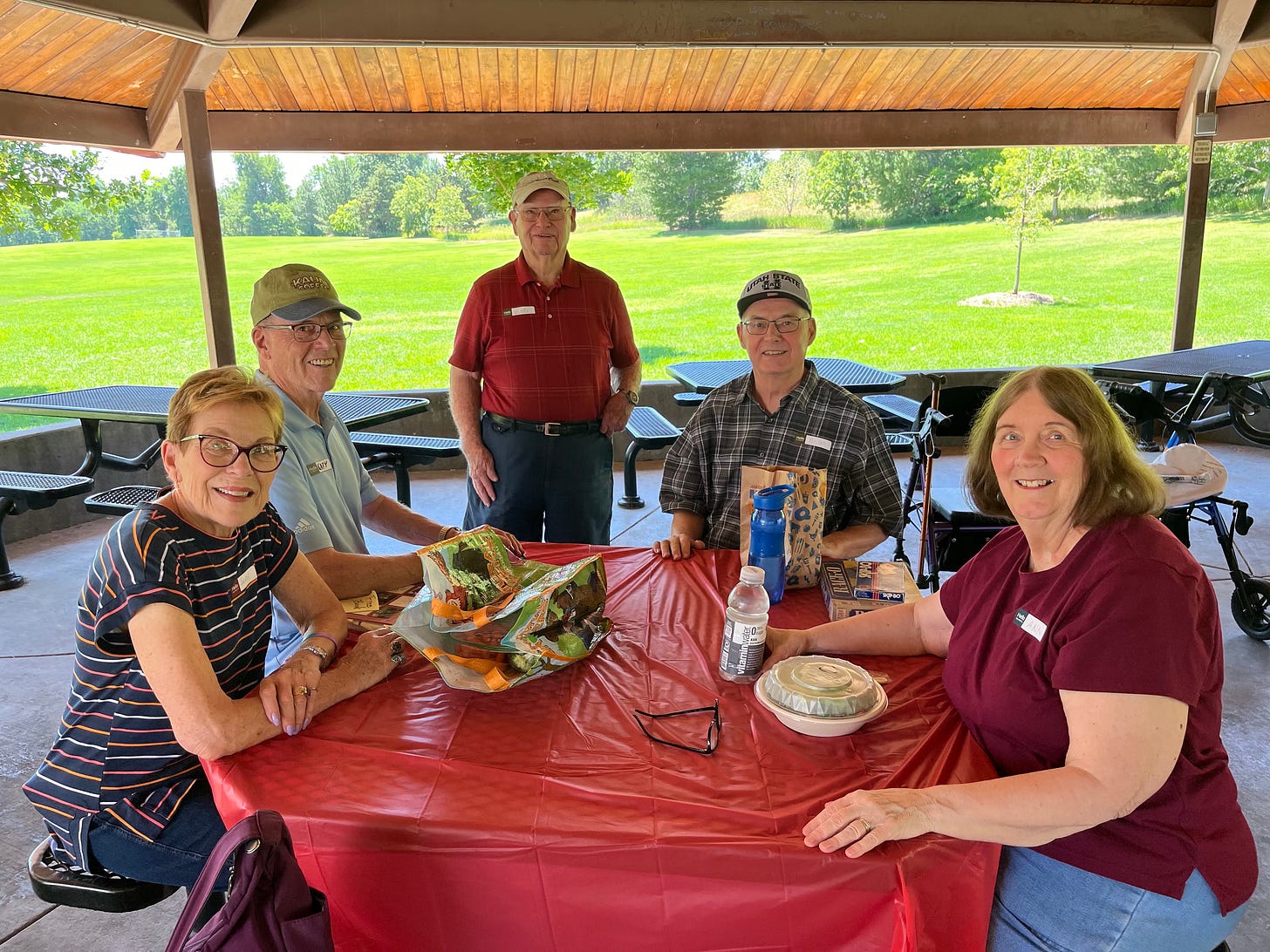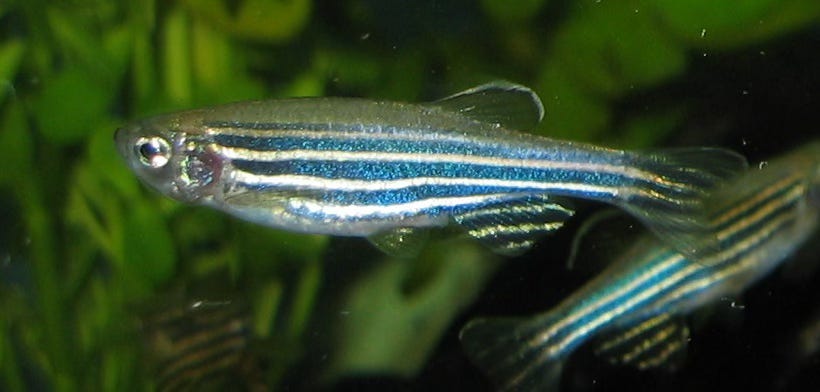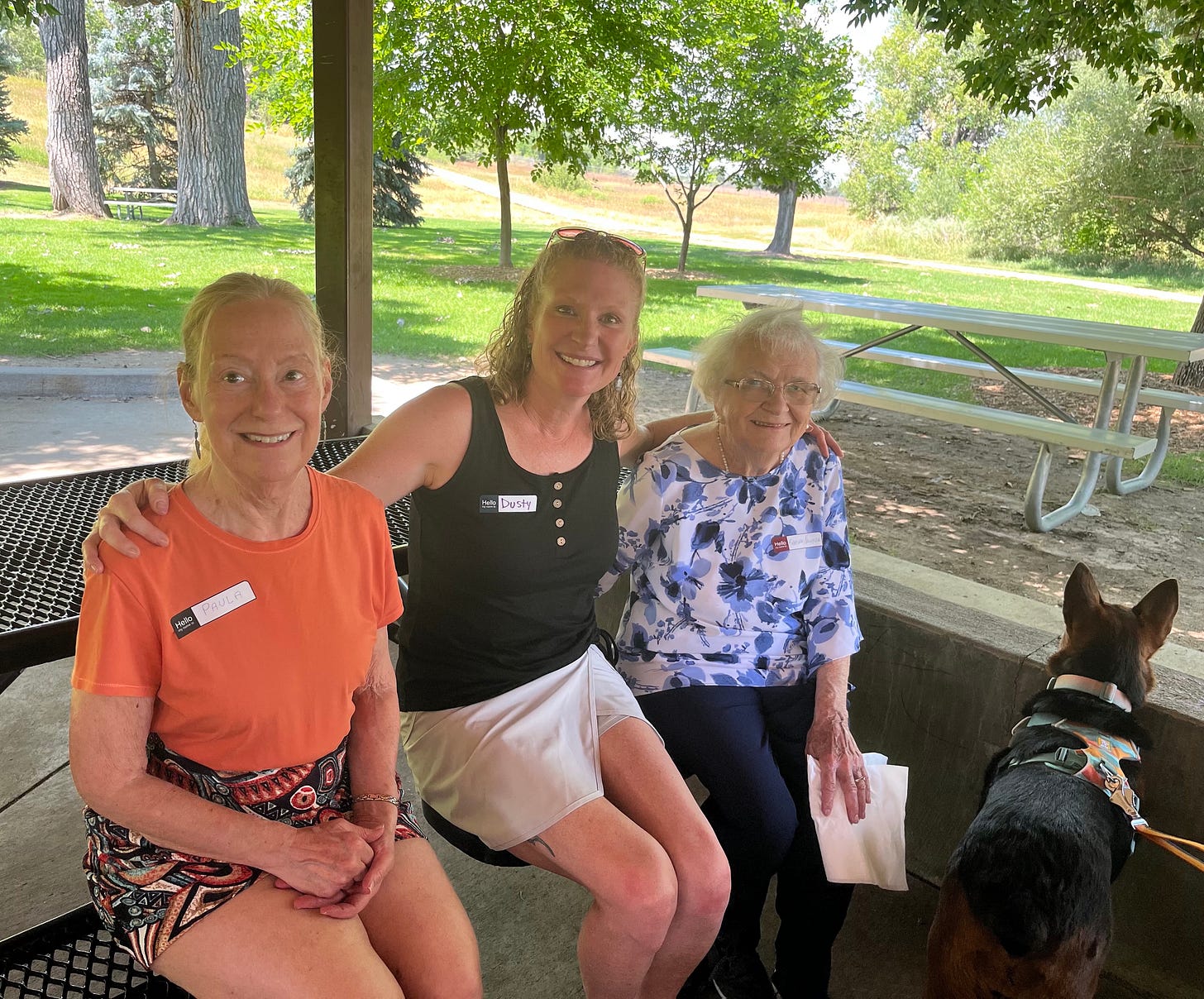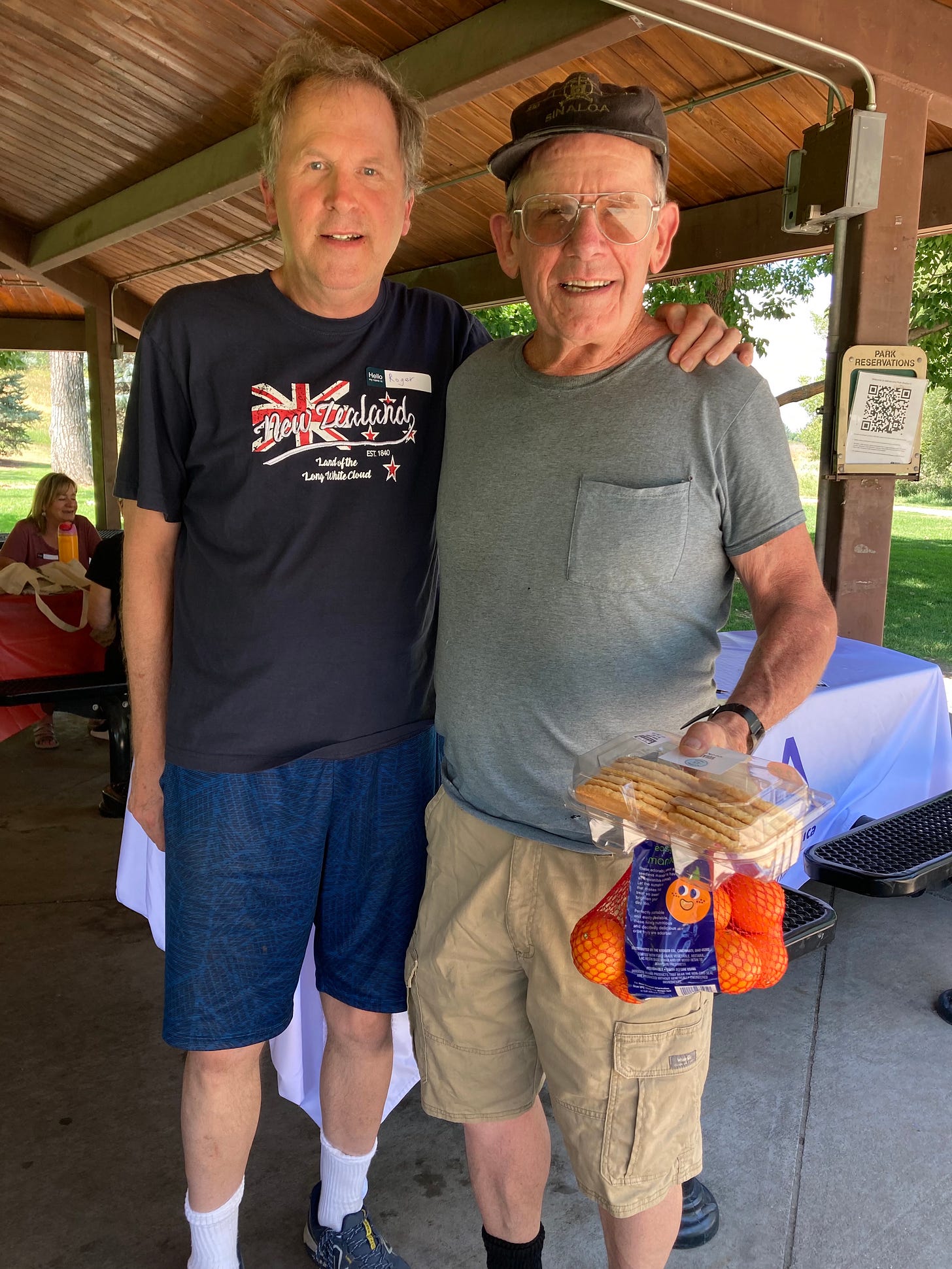Denver Chapter members gather at the July 19 picnic.
Waiting in the wings: Auracast is coming
The technology fans among us have been looking forward to Auracast, but it’s unclear when and where this new service will be available. So now may be a good time to review and update the current state of the art.
Following are exerpts from a few past HAH stories.
From April 2024:
Auracast: the new horizon
One promising new technology that has come along recently is an application of Bluetooth called “Auracast” that pairs devices automatically with public announcements. For example, it will make airports, with their constant noise and confusing announcements, more hospitable for everyone.
Auracast is not yet available. The Bluetooth website is promoting the possibilities while inviting programers (now called developers) to design applications for various sound systems. It explains,
While current assistive listening system (ALS) technologies, such as inductive loops, have been providing great benefit to people with hearing loss, they suffer from a number of challenges that have limited their deployment, including poor quality, high cost, and lack of privacy. Bluetooth worked closely with the hearing aid industry to define and introduce the next generation of assistive listening system technology, Auracast™ broadcast audio.
The company promises both higher quality and lower costs, while taking advantage of the fact that many devices, including many hearing aids, are already Bluetooth compatible. As with loops, there will be one transmitter—as with a radio broadcast—and many receivers.
From November 2024:
Hearing devices ready for Auracast rollout
Auracast, the new Bluetooth-based transmission technology, has not yet taken over many public spaces such as airports and conference centers, but it is making inroads in the hearing device industry. That means when it becomes widely available, hearing aids and a few cochlear implants will be compatible.
According to an article by Stephen O. Frazier in the Fall issue of Hearing Health, the following brands have models that can be paired with over-the-air Auracast transmitters: ReSound, Jabra, Beltone, Signia, Oticon, Phillips, and Rexton. Cochlear's Nucleus 8 cochlear implant processor will be Auracast-capable pending a software update, he adds. Frazier was trained by HLAA as a hearing loss support specialist.
Unlike a hearing loop, an Auracast transmitter brings public announcements directly to a wide variety of devices, such as earbuds and smartphones. As Frazier notes,
Auracast is set to improve audio accessibility for both those with hearing loss and the general public. While it may take years to fully replace older systems, adoption will be quicker in new or upgraded venues. . . Auracast is expected to rapidly grow in use, meeting ADA requirements and becoming a key assistive listening technology for all.
Slow but steady progress
Where is the technology now? A web search indicates progress is still at the level of engineering and design. Companies are sharing products at industry conventions, but few installations seem to be up and running.
One exception is an announcement from broadwayworld.com about a new system in Wyoming. According to the site:
Listen Technologies, a leading provider of advanced wireless listening solutions for 27 years, announced that WYO Performing Arts & Education Center (the WYO) in Sheridan, Wyoming, has installed Auri, powered by Ampetronic and Listen Technologies, for assistive listening in its Main Stage, known as "Sophie's Stage.”
But there are obstacles, and lack of awareness may be one of them.
A recent issue of AV Technology, an online publication, includes this review by Sam Dockrill of Audio Systems Logic:
There’s also a broader conversation around awareness and compliance. I was chatting with an AV staffer at the Gold Coast Convention Centre—his son uses hearing aids—and he wasn’t aware of the differences between hearing augmentation systems. When we talked about receivers, he asked, “What’s the alternative?” I mentioned a hearing loop, and he genuinely didn’t know what a T-coil was. That’s someone directly affected by hearing loss who hadn’t been exposed to this supposedly standard solution.<>
CU study looks at effects of noise-cancelling headphones
By Paula DeJohn
It would seem that noise-cancelling headphones would be of little interest to people with hearing loss; not hearing sounds is one of our problems. But the headphones have their uses in clinical and practical settings, and a recent study by an audiologist at the University of Colorado looked at how they might either protect or damage hearing.
Cory Portnuff, Aud, PhD, assistant clinical professor at the CU School of Medicine, responded to reports that use of the headphones could cause hearing loss and auditory processing disorder, which refers to other types of hearing or comprehension problems. In an article posted on the CU website, he says,
Noise-cancelling headphones are not good at protecting hearing from loud sounds. For example, noise-cancelling headphones are not good enough to be protective from damaging your hearing around loud sounds like a lawnmower or light construction work.
They can help you be able to lower the volume on your music, podcasts or whatever you’re listening to so you don’t have to turn it up so high. Which is good – we don't want people to rely on active noise-cancellation for hearing protection.
The noise-cancelling headphones he is referring to are different from simple ear-covering headphones or earplugs. The latter devices are passive; they keep external sounds out by creating a seal around the ear. Active noise cancelling is more complex. The technology was first patented in the 1950s for aviation use, to protect pilots. They have since become popular with people who want to avoid the distraction of ambient sounds. They work by generating sound waves that are opposite to the surrounding sound waves, cancelling them out.
As Wikipedia explains,
A microphone captures the targeted ambient sounds, and a small amplifier generates sound waves that are exactly out of phase with the undesired sounds. When the sound pressure of the noise wave is high, the cancelling wave is low (and vice versa). The opposite sound waves collide.
They work best, Dr Portnuff says, with steady noise like an airplane engine, but less well for variable sounds like road traffic and human speech.
There's a lot of squeaks and bangs and other loud sounds that are harder to predict in those cases. Some noise-cancelling algorithms can be adjusted even, so you can use an app on your phone to adjust how much it's going to try to block out somebody talking, for example.
Our noise-cancellation headphones have gotten a lot better over the years though. Every year we see significant improvements in the ability of systems to cancel exterior sound. Higher-end pairs, however, are better at blocking those variable noises.
Can they damage hearing?
If these headphones don’t protect from very loud sounds, could they also induce other hearing problems? Dr Portnuff doesn’t think so, despite a British study that reported they may lead to auditory processing disorders. Such disorders are conditions related to hearing but not including hearing loss.
They are disorders of how the brain interprets sound—more specifically, how the brain deals with all of the challenging components of hearing. For example, there are auditory processing disorders that have to do with how we hear between two ears, or how we pull speech out of background noise or how we deal with rapid speech...
When we think about symptoms of auditory processing disorders, we primarily think about people who have difficulty hearing in challenging listening environments but can still hear all the sounds around them like they normally should. A classic example is kids in classrooms who can hear all of the soft sounds around them but have a hard time filtering out the teacher's voice from the noise of kids around them. Or when there are two conversations happening at once, someone is having a hard time being able to home in on just one.
It is not the fault of headphones, however; Dr Portnuff notes that auditory processing disorders are present at birth, or they may result from injuries to the brain or aging. <>
Speech is our common denominator
Since January 2025, the Colorado Division for the Deaf, Hard of Hearing, and DeafBlind (“Division”) has been hosting monthly community meetings to bring together deaf and hard of hearing individuals who use speech. Members may rely on assistive technologies, such as hearing aids, cochlear implants, and captioning, to communicate.
Based on a survey of members, the group chosed the name “Spoken Communication Community.” Among needs they have identified are hearing loops, more widespread captions, and insurance coverage for hearing aids.
For more information or to join the group, email office.cddhhdb@state.co.us.
Here’s a fish story we’d like to believe
In their ongoing efforts to combat hearing loss, scientists have been turning to the examples of our fellow creatures, who, in varying degrees, are able to regrow damaged body parts, including the organs of hearing. The key, according to reports, seems to be the ability to regenerate organs, and that ability depends on genetic factors.
The Hearing Health Foundation, which funds and follows this type of research, announced the latest progress in the August issue of the Hearing Health newsletter. While fish and birds have been considered likely candidates for modeling regeneration, researchers have now zeroed in on one species, the zebrafish.
According to the newsletter report:
Zebrafish are an excellent system for studying regeneration. Dotted in a straight line from their head to tailfin are sensory organs called neuromasts. Each neuromast resembles a garlic bulb with hair cells sprouting from its top. A variety of supporting cells encompass the neuromast to give rise to new hair cells. These sensory cells, which help zebrafish detect water motion, closely resemble those in the human inner ear that detect sound.
The latest research has revealed two genes that are present in the regeneration process. It’s one more step on the path to regrowing the hair cells that enable human hearing.
Our finny friends
Upcoming meeting
The next chapter meeting will be Saturday, September 20, 1 p.m. to 3 p.m. at the Koelbel Library, 5955 South Holly St., Centennial, CO 80121. Chapter Vice President Jennifer McBride will report on her experience at the national HLAA convention in June in Indianapolis, including the presentation she gave as a speaker.
Words to remember
There is just one way to save yourself, and that’s to get together and work and fight for everybody.—Woody Guthrie
From left, Paula, Dusty and Barbara share a bench.
Roger, left, has a surprise reunion with Peter, a fellow Peace Corps volunteer, who was attending another picnic at deKoevend Park in Centennial.






